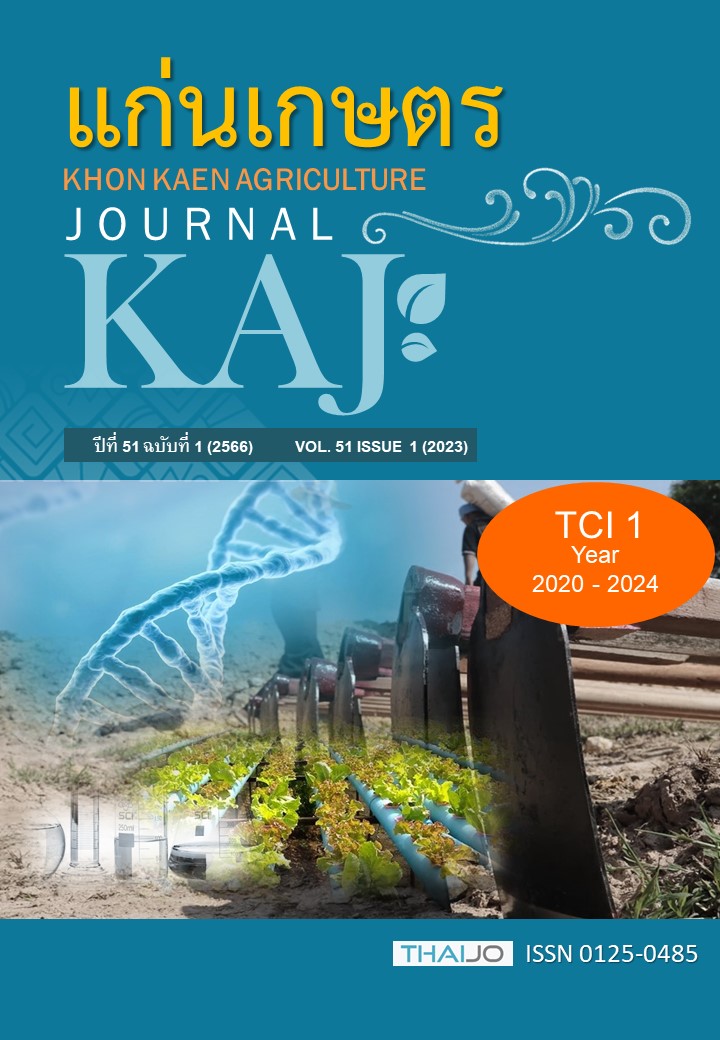การใส่วัสดุอินทรีย์ต่างชนิดกันต่อรูปแบบการสลายตัว กิจกรรมจุลินทรีย์ และสมบัติดินบางประการในพื้นที่ได้รับอิทธิพลจากเกลือที่มีเนื้อดินหยาบ
Main Article Content
บทคัดย่อ
การศึกษานี้มีวัตถุประสงค์เพื่อศึกษา อัตราการสลายตัววัสดุอินทรีย์ การเปลี่ยนแปลงกิจกรรมจุลินทรีย์ สมบัติดินและธาตุอาหารในพื้นที่ที่ได้รับผลกระทบจากเกลือที่มีเนื้อหยาบ หรือที่มีเนื้อดินเป็นดินร่วนปนทราย วางแผนการทดลองแบบสุ่มบล็อกสมบูรณ์ (RCBD) จำนวน 3 ซ้ำ โดยใช้วัสดุอินทรีย์ประกอบด้วยซากถั่วลิสง ใบหญ้าแฝก ฟางข้าว และแกลบซึ่งมีองค์ประกอบทางเคมีต่างกัน ซึ่งซากถั่วลิสงเป็นวัสดุอินทรีย์ที่มีไนโตรเจนเป็นองค์ประกอบสูง ในขณะแกลบมีปริมาณลิกนินและเซลลูโลสสูง ผลการศึกษาพบว่า อัตราการสลายตัวเกิดขึ้นเร็วในช่วงแรก (k1) โดยเฉพาะช่วง 2 สัปดาห์แรก ซึ่งมีอัตราสลายตัวสูงสุดในดินที่ใส่หญ้าแฝก และเกิดการสลายตัวล่าช้าในช่วงหลัง (k2) อัตราการสลายตัวมีสหสัมพันธ์ทางลบกับคาร์บอนในวัสดุอินทรีย์ (r= -0.906**) และสหสัมพันธ์ทางบวกกับอัตราส่วนของคาร์บอนต่อไนโตรเจน (r= 0.729*) และยังพบว่า กิจกรรมของจุลินทรีย์ในดินจากการปลดปล่อย CO2 ที่เกิดขึ้นทันทีโดยเฉพาะดินที่ใส่ซากถั่วลิสง และแกลบซึ่งปริมาณ CO2 ที่ปลดปล่อยขึ้นอยู่กับปริมาณไนโตรเจน (r= 0.723**) และลิกนิน (r= 0.771**) ในวัสดุอินทรีย์ สำหรับปริมาณมวลชีวภาพจุลินทรีย์คาร์บอน (MBC) และไนโตรเจน (MBN) พบในช่วงสัปดาห์ที่ 8 มีค่าสูงสุดในดินที่ใส่ฟางข้าวและซากถั่วลิสงสำหรับ MBC และ MBN ในขณะที่ประสิทธิภาพของจุลินทรีย์ (qCO2) เพิ่มขึ้นในดินที่ใส่ซากถั่วลิสง และลดลงในดินที่ใส่ฟางข้าว นอกจากนี้ การใส่วัสดุอินทรีย์ช่วยทำให้ความหนาแน่นรวมของดินลดลง ดินอุ้มน้ำได้มากขึ้น ค่าการนำไฟฟ้าลดลง ค่าความจุการแลกเปลี่ยนแคทไอออนของดินเพิ่ม ดินมีความเข้มข้นของธาตุอาหารเพิ่มขึ้นประกอบด้วยไนโตรเจนทั้งหมดในดิน ฟอสฟอรัสที่เป็นประโยชน์ โพแทสเซียม แคลเซียม แมกนีเซียม โซเดียมที่แลกเปลี่ยนได้ซึ่งส่วนหนึ่งขึ้นอยู่กับสภาพความชื้นดิน ซึ่งสะท้อนให้เห็นถึงการเปลี่ยนแปลงที่นำไปสู่การจัดการดิน น้ำ และปุ๋ยในการปลูกข้าวในดินเนื้อหยาบ
Article Details

อนุญาตภายใต้เงื่อนไข Creative Commons Attribution-NonCommercial-NoDerivatives 4.0 International License.
เอกสารอ้างอิง
กรมพัฒนาที่ดิน. 2553. คู่มือการปฏิบัติงานกระบวนการวิเคราะห์ตรวจสอบดินทางเคมี. กรมพัฒนาที่ดิน กระทรวงเกษตรและสหกรณ์. กรุงเทพฯ.
กรมพัฒนาที่ดิน. 2558. สถานภาพทรัพยากรดินและที่ดินของประเทศไทย. กรมพัฒนาที่ดิน กระทรวงเกษตรและสหกรณ์. กรุงเทพฯ.
ทัศนีย์ อัตตะนันทน์, จงรักษ์ จันทร์เจริญสุข และสุรเดช จินตกานนท์. 2532. คู่มือปฏิบัติการวิเคราะห์ดินและพืช. ภาควิชาปฐพีวิทยา คณะเกษตร มหาวิทยาลัยเกษตรศาสตร์. 393 หน้า.
ธงชัย มาลา. 2558. อินทรีย์วัตถุและจุลินทรีย์ดินเพื่อการเพาะปลูก. คัมภีร์ดินและปุ๋ยไทย. สมาคมการค้าผู้ผลิตปุ๋ยไทย.
เพิ่มพูน กีรติกสิกร. 2527. ดินภาคตะวันออกเฉียงเหนือของประเทศไทย. ภาควิชาปฐพีศาสตร์ คณะเกษตรศาสตร์ มหาวิทยาลัยขอนแก่น.
ไพรัช พงษ์วิเชียร, พรรณี หงส์น้อย และปราโมทย์ แย้มคลี่. 2544. การใช้วัสดุปรับปรุงดินเพื่อปลูกอินทผลัมในพื้นที่ดินเค็ม. กลุ่มปรับปรุงดินเค็ม. กองอนุรักษ์ดินและน้ำ. กรมพัฒนาที่ดิน. กระทรวงเกษตรและสหกรณ์. กรุงเทพฯ.
ภัทรวลัญชญ์ สามหาดไทย. 2550. การเปลี่ยนแปลงอินทรียวัตถุและรูปไนโตรเจนในดินไร่เนื้อทรายที่ได้รับซากพืชคุณภาพต่างกันในระยะยาว. วิทยานิพนธ์ปริญญาวิทยาศาสตรมหาบัณฑิต สาขาทรัพยากรที่ดินและสิ่งแวดล้อม มหาวิทยาลัยขอนแก่น. 151 หน้า.
สมพล ไวปัญญา, พิสุทธิ์ สุขเกษม, และเกียรติสุรักษ์ โภคสวัสดิ์. 2542. รายงานผลการวิจัย:สถานะธาตุอาหารพืชที่มีต่อผลผลิตและความเข้มข้นของหญ้าชันกาดในชุดดินบ้านทอน. กรุงเทพฯ: กรมปศุสัตว์.
เสรี จาตุรงคกุล, เมธี ธรรมประทีป, อุกฤษฎ์ สุวรรณสมบูรณ์ และจารึก แทนบุญ. 2528. การศึกษาการใช้อินทรียวัตถุ (แกลบ) ปรับปรุงโครงสร้างดินเค็มอีสาน. กลุ่มปรับปรุงดินเค็ม. กองอนุรักษ์ดินและน้ำ. กรมพัฒนาที่ดิน. กระทรวงเกษตรและสหกรณ์. กรุงเทพฯ.
Anderson, J.P.E. 1982. Soil respiration. In: Page, A.L., R.H. Miller, and D.R. Keeney. (Eds.). Agronomy Monograph Number 9, Part II. (p.p. 831-871). Madison: American Society of Agronomy and Soil Science Society of America.
Anderson, J.M., and J.S.I. Ingram. 1993. Tropical Soil Biology and Fertility: A Handbook of methods. CAB international, Wallingford, UK.
Anderson, T.H., and K.H. Domsch. 1993. The metabolic quotient for CO2 (qCO2) as a specific activity parameter to assess the effects of environmental conditions, such as pH, on the microbial biomass of forest soils. Soil Biology. Biochemistry. 25: 393-395.
Anderson, T.H. and K.H. Domsch. 1986. Carbon link between microbial biomass and soil organic matter, pp. 467-471. Proceedings of the 4th International Symposium on Microbial Ecology, Ljubljana, Yugoslavia.
Amato, M., and J.N. Ladd, 1988. Assay for microbial biomass based on ninhydrin reaction nitrogen in extracts of fumigated soil. Soil Biology. Biochemistry. 20: 107-114.
Arunin, S., A. Yuvaniyama, T. Subhasaram, P. Rungsangchan, and N. Puengpan. 1987f. Changes of organic matters in saline soils (in Thai). Annual Technical Report. Soil and Water Conservation and Management Division., Land Development Department., Bangkok, Thailand. P. 220-227.
Gachengo, C.N., B. Vanlauwe, and C.A. Palm. 2004. Mineralization patterns of selected organic materials. pp. 54-61. In R.J. Delve, and M.E. Probert, (Ed.), Modeling nutrient management in tropical cropping systems. ACIAR Proceedings No. 114.
Goto, I., M. Ninaki, P. Patcharapreecha, and B. Topark-ngarm, 1987. Limiting factors for crop growth in salinesoils. In Coastal and Inland Salt-Affected Soils in Thailand. Nodai Research Institute. Toyko University of Agriculture. 280 p.
Neely, C.L., H. Beare, L. Hargrove and C. Coleman. 1991. Relationship between fungal and bacterial substrate-induced respiration, biomass and plant residue decomposition. Soil Biology. Biochemistry. 23: 947-954.
Olson, J.S. 1963. Energy storage and balance of producers and decomposers in ecological systems. Ecology. 44: 322-331.
Paul, E.A., and F.E. Clark. 1989. Soil microbiology and biochemistry. Academic Press. San Diego, USA.
Puttaso, A., P. Vityakon, P. Saenjan, V. Tre-loges, and G. Cadisch. 2011. Relationship between residue quality, decomposition patterns, and soil organic matter accumulation in a tropical sandy soil after 13 years. Journal of Nutrient Cycling in Agroecosystem. 89: 159-174.
Sorensen, P., J.N. Ladd, and M. Amato. 1996. Microbial assimilation of 14C of ground and unground plant materials decomposing in a loamy sand and clay soil. Soil Biology. Biochemistry. 28: 1425-1434.
Tate, K.R., and C.W. Feltham. 1988. A direct extraction method to estimate soil microbial C: effect of experiment variables and somesome different calibration procedures. Soil Biology Biochemistry. 20: 329-335.
Topark-ngarm, B. 1988. Studies on increasing productivity of saline Soils. Ph.D Thesis. Tokyo University of Agriculture, Tokyo, Japan.
Topark-ngarm, B., P. Patcharapreecha, I. Goto, and M. Kimura. 1990. Studies on saline soils in Khon Kaen Region, Northeast Thailand. II. Seasonal changes of physical and chemical properties. Soil Science and Plant Nutrition. 36: 289-298.
Van Soest, P.J., and E.H. Wine. 1968. Determination of lignin and cellulose in acid detergent fibre with permanganate. Journal Association of Official Analytical Chemists. 51: 780-785.
Vance, E.D., P.C. Brookes, and D.S. Jenkinson. 1987. An extraction method for measuring soil microbial biomass C. Soil Biology Biochemistry. 19(6): 703-707.
Vityakon, P. 1993. The traditional trees-in-paddy-fields agroecosystem of Northeast Thailand: Its potential for agroforestry development. Working paper No. 34. Program on Environment. Honolulu, Hawaii: East West Center.
Vityakon, P., S. Meepetch, G. Cadisch, and B. Toomsan. 2000. Soil organic matter and nitrogen transformation mediated by plant residues of different quality of sandy acid upland and paddy soil. Netherlands Journal of Agricultural Science. 48: 75-90.


